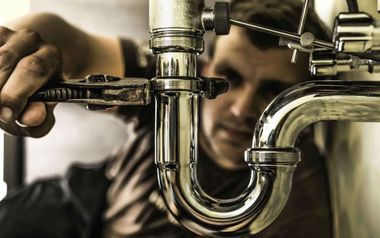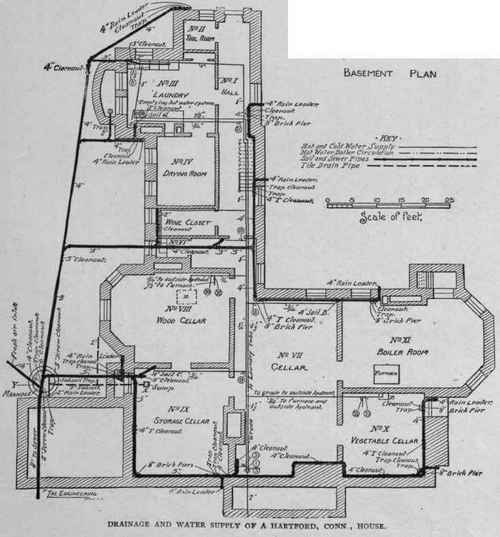How to Understand Your Property's Plumbing System Anatomy
How to Understand Your Property's Plumbing System Anatomy
Blog Article
What are your beliefs about Anatomy of a House: Understanding the Components?

Comprehending how your home's pipes system works is essential for each property owner. From supplying clean water for alcohol consumption, cooking, and bathing to securely eliminating wastewater, a well-kept plumbing system is crucial for your family members's health and wellness and comfort. In this detailed overview, we'll check out the intricate network that composes your home's plumbing and offer suggestions on upkeep, upgrades, and managing typical problems.
Intro
Your home's plumbing system is more than simply a network of pipelines; it's a complex system that guarantees you have accessibility to tidy water and efficient wastewater removal. Understanding its elements and how they work together can assist you protect against pricey repair work and guarantee whatever runs efficiently.
Standard Elements of a Pipes System
Pipelines and Tubing
At the heart of your plumbing system are the pipes and tubing that bring water throughout your home. These can be made from numerous products such as copper, PVC, or PEX, each with its benefits in regards to durability and cost-effectiveness.
Fixtures: Sinks, Toilets, Showers, etc.
Fixtures like sinks, bathrooms, showers, and tubs are where water is utilized in your home. Comprehending exactly how these fixtures connect to the plumbing system assists in identifying issues and preparing upgrades.
Valves and Shut-off Points
Valves manage the flow of water in your plumbing system. Shut-off valves are important throughout emergencies or when you need to make repairs, enabling you to separate parts of the system without interrupting water flow to the entire residence.
Water System System
Main Water Line
The primary water line links your home to the community water supply or a private well. It's where water enters your home and is dispersed to numerous components.
Water Meter and Stress Regulatory Authority
The water meter actions your water use, while a pressure regulator makes certain that water moves at a secure stress throughout your home's plumbing system, stopping damage to pipes and fixtures.
Cold Water vs. Hot Water Lines
Understanding the distinction between cold water lines, which supply water directly from the primary, and hot water lines, which bring warmed water from the hot water heater, aids in repairing and preparing for upgrades.
Water drainage System
Drain Pipes and Traps
Drain pipelines lug wastewater away from sinks, showers, and toilets to the sewage system or septic system. Traps protect against sewage system gases from entering your home and additionally catch debris that could create blockages.
Ventilation Pipes
Ventilation pipelines enable air into the water drainage system, stopping suction that could reduce drain and cause catches to empty. Appropriate ventilation is crucial for preserving the integrity of your pipes system.
Significance of Appropriate Drainage
Making certain appropriate drainage protects against back-ups and water damage. Consistently cleaning drains pipes and preserving catches can prevent pricey repair work and expand the life of your plumbing system.
Water Furnace
Kinds Of Hot Water Heater
Water heaters can be tankless or typical tank-style. Tankless heating units warmth water on demand, while storage tanks store warmed water for immediate use.
Upgrading Your Pipes System
Reasons for Updating
Updating to water-efficient fixtures or changing old pipes can enhance water quality, minimize water costs, and increase the worth of your home.
Modern Pipes Technologies and Their Benefits
Discover technologies like wise leakage detectors, water-saving toilets, and energy-efficient hot water heater that can save money and decrease ecological influence.
Price Factors To Consider and ROI
Compute the upfront costs versus long-term cost savings when thinking about plumbing upgrades. Lots of upgrades spend for themselves via lowered energy expenses and less fixings.
Just How Water Heaters Link to the Pipes System
Recognizing just how hot water heater attach to both the cold water supply and hot water circulation lines aids in diagnosing problems like not enough warm water or leaks.
Maintenance Tips for Water Heaters
Consistently purging your hot water heater to remove sediment, checking the temperature setups, and evaluating for leakages can extend its life-span and enhance power efficiency.
Typical Pipes Issues
Leaks and Their Reasons
Leaks can happen because of maturing pipelines, loose fittings, or high water stress. Resolving leakages promptly protects against water damages and mold growth.
Clogs and Blockages
Clogs in drains pipes and commodes are often brought on by purging non-flushable things or a build-up of grease and hair. Utilizing drain screens and being mindful of what decreases your drains can avoid blockages.
Indications of Plumbing Issues to Watch For
Low tide stress, slow-moving drains pipes, foul odors, or uncommonly high water expenses are indications of potential plumbing troubles that need to be resolved without delay.
Pipes Upkeep Tips
Routine Evaluations and Checks
Schedule annual pipes examinations to capture problems early. Try to find signs of leakages, deterioration, or mineral accumulation in faucets and showerheads.
DIY Maintenance Tasks
Straightforward jobs like cleansing faucet aerators, checking for commode leakages utilizing dye tablet computers, or protecting exposed pipes in cool climates can prevent significant pipes issues.
When to Call a Professional Plumbing Technician
Know when a plumbing issue calls for specialist competence. Attempting complex fixings without appropriate expertise can cause more damages and higher fixing costs.
Tips for Lowering Water Usage
Straightforward practices like dealing with leaks without delay, taking shorter showers, and running complete lots of laundry and recipes can save water and reduced your utility costs.
Eco-Friendly Pipes Options
Consider sustainable pipes materials like bamboo for floor covering, which is durable and environment-friendly, or recycled glass for countertops.
Emergency situation Preparedness
Actions to Take During a Pipes Emergency
Know where your shut-off shutoffs are located and just how to shut off the supply of water in case of a ruptured pipe or significant leak.
Value of Having Emergency Get In Touches With Convenient
Keep get in touch with details for regional plumbers or emergency situation solutions easily offered for quick action during a plumbing situation.
Environmental Effect and Conservation
Water-Saving Fixtures and Devices
Installing low-flow taps, showerheads, and toilets can considerably minimize water use without giving up performance.
DIY Emergency Fixes (When Suitable).
Short-lived fixes like utilizing air duct tape to spot a leaking pipe or putting a pail under a trickling tap can minimize damage until an expert plumbing shows up.
Final thought.
Comprehending the makeup of your home's pipes system encourages you to maintain it properly, saving time and money on repair services. By adhering to regular maintenance routines and remaining educated concerning modern plumbing innovations, you can guarantee your pipes system runs efficiently for years to come.
HOW YOUR PLUMBING SYSTEM WORKS
Which Pipes Do What?
Blue lines = fresh water supply entering the building Red lines = hot water supply entering the building Grey lines = pipes carrying waste away from the building and venting pipes carrying gases away from the building (through the roof) YOUR MAIN PLUMBING SYSTEMS
There are two main plumbing systems that support your home s basic plumbing needs one that brings clean water into your home, and one that sends dirty water away from your home. Connected to the toilet, bath, shower, and other faucets in your home, these two systems keep your water flowing in the right directions.
ACCESSING FRESH WATER
Fresh and clean water is brought into your home through the main water supply line . Filtered through one pipe, this water is pressured to flow into the various fixtures in your home at any given time.
This water can be sourced from a well located on your property, a pond or river (mostly cottages), or, as in most cases, from the city s municipal water treatment centre. However, it is important to note that water that is untreated, such as the water siphoned from ponds or rivers, may not be safe to drink. Personal water supplies always need to be treated for hardness and contaminants before consumed.
MUNICIPAL WATER SUPPLIES
Improve taste and odour Remove sediment Eliminate hardness Reduce chlorine COLD WATER SUPPLY VS. HOT WATER SUPPLY
Cold water flows into your home or building through the service line, which then distributes hot or cold water to your fixtures. This line is most commonly run through a central column that runs floor to floor. Hot water runs in short and straight pipes as the longer the pipeline, the more heat that will be lost in the transfer. Having shorter pipes also allows residents to access hot water more quickly.
WASTE WATER SYSTEM
Your wastewater system is divided into two parts pipes that send wastewater away from your home and venting pipes that send sewer gas away from your home. Sewage water travels through pipes that flush the water and waste towards local sewers that are operated and managed by your city or town. Most sewer systems rely on gravity to move the wastewater to where it needs to go.
The further away from your toilet or sink, the larger wastewater pipes become. This allows for waste to be disposed of from various parts of your home or business at once without pipe blockages. The angle and flow of these pipes are also essential for keeping your waste pipes clear of build up.
https://harrisplumbing.ca/how-your-home-plumbing-system-works/

I'm certainly very fascinated by Understanding Your Home's Plumbing Anatomy and I really hope you enjoyed reading the new blog posting. You should take a moment to promote this page if you liked it. Many thanks for going through it.
View Website Report this page